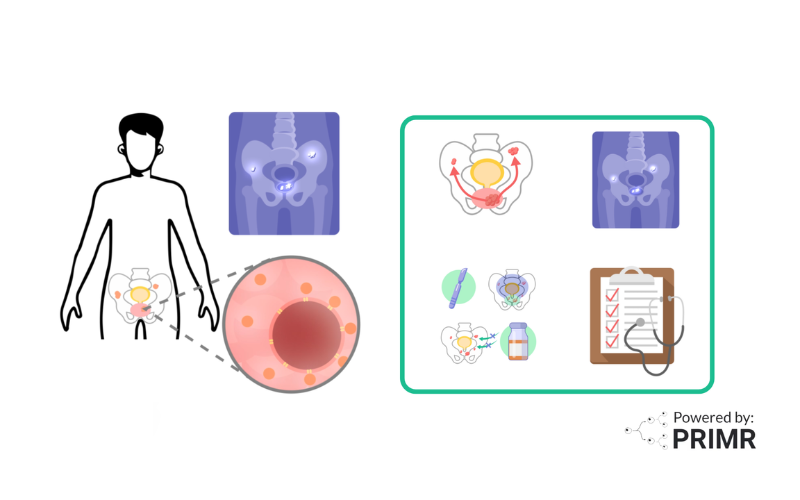What is Active Surveillance for Prostate Cancer? Introducing the ESCAPE trial.

By: David Grew MD MPH
Exciting advancements in active surveillance for prostate cancer are emerging, including the groundbreaking ESCAPE trial.
∗ ∗ ∗
By now most of us intuitively understand that not all cancers are created equal. Some are gutting - like pancreatic cancer and glioblastoma. They grow so fast and shrug off even the most aggressive treatment. While other cancers are indolent, or slow growing. In some cases, these slow growing cancers don’t need any treatment at all - they can simply be watched closely for signs of growth.
In this blog post we’ll review a case where cancer is monitored closely but not treated: active surveillance for prostate cancer. We’ll review some basic foundational concepts around active surveillance. We’ll wrap by introducing the ESCAPE trial for men with prostate cancer who want to avoid treatment.
This blog is of course for education purposes only and is not medical advice.
What is Active Surveillance for Prostate Cancer?
Active surveillance is a proactive management strategy for prostate cancer that involves closely monitoring the disease progression rather than pursuing immediate treatment. This approach is primarily recommended for patients who have low-risk or early-stage prostate cancer. By conducting regular tests and assessments, healthcare professionals can determine whether intervention is necessary or if the cancer remains indolent.
Which Patients are Eligible for Prostate Cancer Active Surveillance?
Patients diagnosed with low-risk prostate cancer, characterized by slow-growing tumors and favorable prognostic indicators, are often suitable candidates for active surveillance. Eligibility criteria typically include a low prostate-specific antigen (PSA) level, a Gleason score of 6 or less, and a limited extent of cancer detected during biopsies. However, each patient's situation is unique, and a comprehensive evaluation by a healthcare provider is crucial to determine eligibility. In some cases, men with favorable intermediate risk prostate cancer are candidates for active surveillance. You should talk to your doctor about whether or not you are a candidate for active surveillance.
What are the advantages of Active Surveillance?
Active surveillance presents several advantages that make it an attractive option for eligible prostate cancer patients. Firstly, it allows individuals to avoid unnecessary treatment side effects and associated complications. By closely monitoring the disease, patients can maintain a high quality of life while deferring more invasive interventions. Secondly, active surveillance minimizes the financial burden often associated with immediate treatments, providing patients with additional time to make informed decisions about their healthcare.
What are the risks of Active Surveillance?
While active surveillance offers numerous benefits, it is essential to acknowledge the potential risks involved. The primary concern is disease progression during surveillance, which may lead to missed opportunities for early intervention. If cancer exhibits signs of aggression or spreads beyond the prostate, treatment options become more limited, and the chances of successful outcomes may diminish. It is crucial for patients under active surveillance to adhere to regular follow-up appointments and diligently track any changes in their condition.
What are the other options or alternatives to Active Surveillance?
For patients who may not be eligible for or comfortable with active surveillance, alternative treatment approaches are available. These may include surgery (radical prostatectomy) to remove the prostate gland, radiation therapy (external beam or brachytherapy), or focal therapies targeting specific areas of cancerous growth. Each alternative has its own set of benefits and considerations, and a thorough discussion with healthcare professionals can help determine the most suitable option for individual patients.
The ESCAPE Trial: Exploring PSMA PET CT for Active Surveillance
Exciting advancements are being made in the field of active surveillance for prostate cancer. One noteworthy study is the ESCAPE trial, which investigates the integration of PSMA PET CT (Prostate-Specific Membrane Antigen Positron Emission Tomography Computed Tomography) with traditional active surveillance tests such as PSA measurements, biopsies, and magnetic resonance imaging (MRI). The aim is to enhance the accuracy of monitoring disease progression and facilitate timely intervention if necessary. Early findings from the trial show promising results, underscoring the potential of this innovative approach to revolutionize prostate cancer management. If you’re interested in enrolling, you can view the video here and fill the form to be connected to a trial site.
FAQs:
How frequently do patients on active surveillance for prostate cancer undergo tests and assessments to monitor disease progression?
Patients on active surveillance for prostate cancer typically undergo tests every three to six months initially. These assessments commonly include prostate-specific antigen (PSA) measurements and digital rectal exams (DREs). Periodic prostate biopsies are performed typically every 12-18 months. The frequency of these evaluations may vary depending on individual risk factors and the recommendations of healthcare providers.
Are there specific lifestyle changes or interventions recommended for patients on active surveillance to optimize their overall health and potentially reduce the risk of disease progression?
Yes. These lifestyle modifications may include maintaining a healthy diet rich in fruits, vegetables, and whole grains, engaging in regular physical activity, managing stress levels, avoiding tobacco use, and moderating alcohol consumption. Additionally, some patients may benefit from incorporating stress-reduction techniques such as meditation or yoga into their daily routines.
What are the long-term outcomes and survival rates for patients who undergo active surveillance for prostate cancer compared to those who receive immediate treatment?
While active surveillance offers the advantage of avoiding the potential side effects and complications associated with immediate treatments such as surgery or radiation therapy, its efficacy in terms of long-term outcomes is still being studied. Research indicates that carefully selected patients on active surveillance can achieve favorable outcomes comparable to those of patients who undergo immediate treatment, with low rates of disease progression and overall survival rates similar to the general population. However, long-term studies with extended follow-up periods are needed to provide more comprehensive insights into the comparative effectiveness of active surveillance versus immediate treatment strategies for prostate cancer.
Other Posts

Nuclear Medicine: PSMA Treatment Explained from a Doctor’s Perspective

Nuclear Medicine: PSMA Imaging and Its Impact on Prostate Cancer Care
